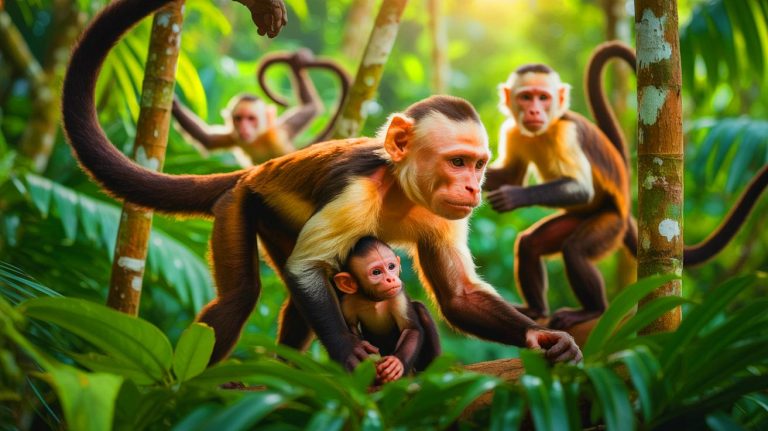| IN A NUTSHELL |
|
On the remote Jicarón Island, nestled within Panama’s Coiba National Park, an unusual and perplexing behavior has emerged among the local white-faced capuchin monkeys. These primates have begun abducting infant howler monkeys, a phenomenon that has captivated scientists and sparked significant interest in the scientific community. Initially dismissed as a rare occurrence, this peculiar behavior has burgeoned into a notable trend, prompting researchers to delve deeper into its origins and implications. As researchers uncover more about this bizarre behavior, they are left pondering how this newfound tradition might impact both the capuchins and the vulnerable howler monkeys.
A Strange Discovery in the Woods
In 2022, doctoral researcher Zoë Goldsborough made an astonishing discovery while reviewing footage from motion-activated cameras on Jicarón Island. These cameras were originally set up to study the island’s stone tool-using capuchins. To her surprise, the footage revealed a male capuchin monkey carrying an infant howler monkey on his back, an unprecedented and unexpected interspecies interaction. Upon further investigation, Goldsborough discovered multiple instances of this behavior, primarily involving a subadult male capuchin she nicknamed “Joker.”
Initially, researchers speculated that this might be an isolated case of adoption. However, the fact that a male was the exclusive carrier of these infants suggested a different narrative. As time passed, it became evident that Joker was not alone in this behavior. Other young male capuchins began to replicate the action, suggesting a burgeoning trend rather than a singular oddity. According to Brendan Barrett, another researcher involved in the study, this behavior reflects the capuchins’ deep curiosity and their constant exploration of their forest environment.
Oddity to Trend?
Over a period of 15 months, researchers documented 11 separate instances of capuchins abducting howler infants. These infants, often under four weeks old, were seen clinging to their captors as they navigated the forest. Unfortunately, the capuchins were unable to provide the necessary sustenance for the infants, resulting in their demise. Goldsborough emphasizes that while the capuchins did not harm the infants, they were incapable of providing the milk required for their survival.
This behavior is described as a “social tradition” or cultural fad, originating with a single individual and spreading through social learning. The researchers found no clear benefit to the capuchins, nor any significant costs, aside from potentially complicating their use of tools. Barrett highlights that this phenomenon demonstrates that non-human animals can develop cultural traditions lacking clear functions but with potentially destructive outcomes. The critical question remains: why did this tradition arise specifically in this environment?
Conservation Concerns
The unique conditions on Jicarón Island may hold the key to understanding this behavior. Meg Crofoot, managing director at the Max Planck Institute of Animal Behavior, suggests that the absence of predators and competitors creates a “luxurious” environment for the capuchins, allowing them ample time for innovation. This environment may foster creativity and boredom-driven behaviors among these intelligent primates.
The potential conservation implications of this behavior are significant. With howler monkeys already endangered on the island, the continued abduction of their infants could exacerbate their declining population. As researchers continue to monitor the situation, they remain acutely aware of their responsibility to learn from and protect this unique population of primates. Witnessing the spread of this behavior has profoundly impacted the research team, reinforcing their commitment to understanding the complexities of these animals’ behaviors.
The Path Forward
The burgeoning trend of capuchin monkeys abducting infant howler monkeys on Jicarón Island presents researchers with a rare opportunity to study cultural evolution in non-human animals. This phenomenon raises intriguing questions about the social dynamics and environmental factors that influence such behaviors. As scientists delve deeper into this mystery, they aim to uncover the underlying motivations and potential consequences for both species involved.
While the immediate effects of this behavior on the capuchins appear minimal, the long-term implications for the howler monkey population could be dire. As researchers continue to observe and analyze this unique behavior, they remain committed to unraveling the complexities of interspecies interactions and their broader impact on the ecosystem. How will this newfound tradition shape the future of these primates and the delicate balance of their island habitat?
Did you like it? 4.7/5 (22)





Wow, I never knew monkeys could be so mean! 😲
Doesn’t this behavior show that animals can be as complex as humans?
Why are they doing this? Is it a form of play or something more sinister?
Great article, but I’m curious how researchers plan to stop this behavior. 🤔
The capuchins sound like they’re just bored. Maybe they need enrichment activities?
Is there any evidence of this behavior in other parts of the world?
So the capuchins are like the bullies of the monkey world, huh?
Thanks for shedding light on this issue. I hope the howler monkeys get some help soon.
It’s kind of sad that the howler infants don’t survive. 😢
Could this behavior be a result of environmental changes on the island?
This sounds like something out of a monkey soap opera! 😂